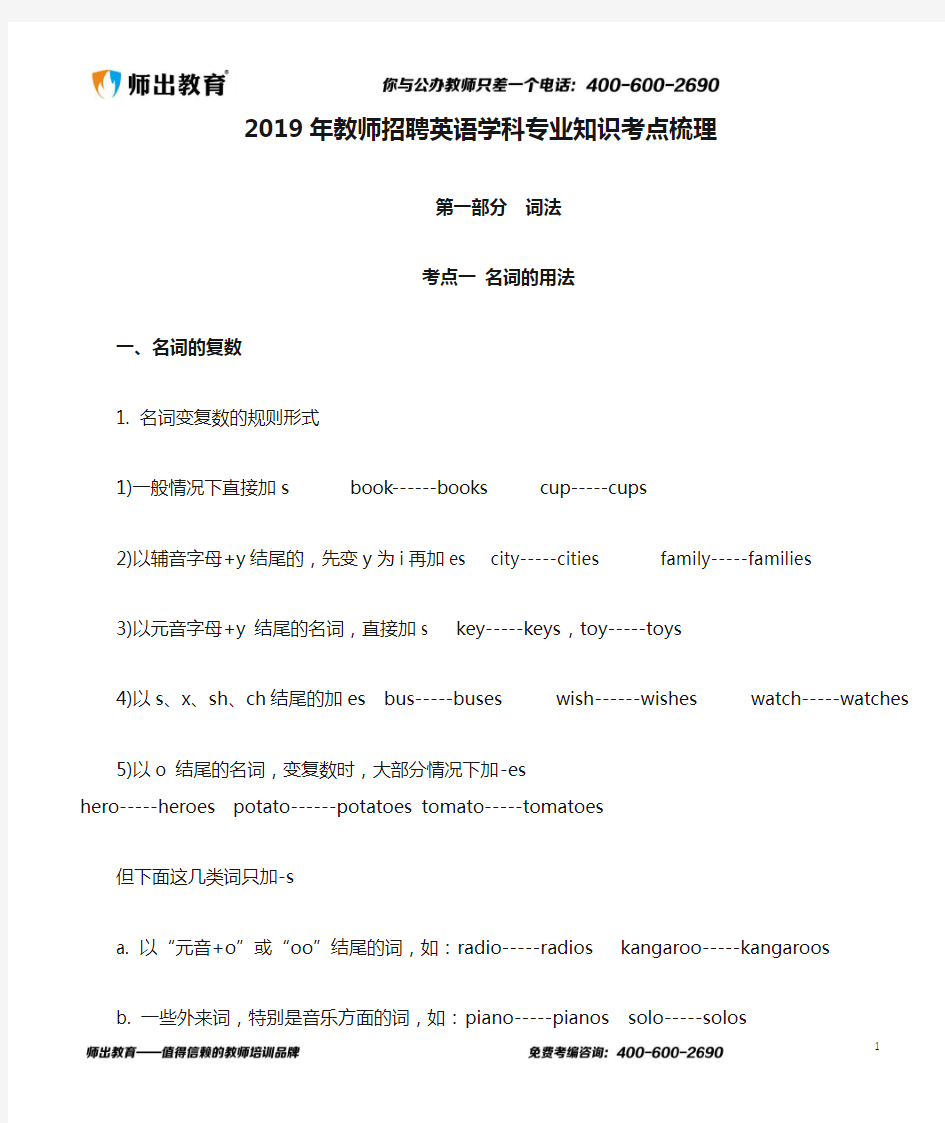(一)2019年教师招聘英语学科专业知识考点梳理


2019年教师招聘英语学科专业知识考点梳理
第一部分词法
考点一名词的用法
一、名词的复数
1. 名词变复数的规则形式
1)一般情况下直接加s book------books cup-----cups
2)以辅音字母+y结尾的,先变y为i再加es city-----cities family-----families
3)以元音字母+y 结尾的名词,直接加s key-----keys,toy-----toys
4)以s、x、sh、ch结尾的加es bus-----buses wish------wishes watch-----watches
5)以o 结尾的名词,变复数时,大部分情况下加-es
hero-----heroes potato------potatoes tomato-----tomatoes
但下面这几类词只加-s
a. 以“元音+o”或“oo”结尾的词,如:radio-----radios kangaroo-----kangaroos
b. 一些外来词,特别是音乐方面的词,如:piano-----pianos solo-----solos tobacco-----tobaccos
c. 一些缩写词和专有名词,如:kilo(kilogram/kilometer)-----kilos photo(photograph)-----photos Eskimo-----Eskimos
d. 个别词加-es,-s都可以,如:halo-----halos/haloes
6)以f、fe 结尾的,先把f、fe变v 再加es .
leaf----leaves self---selves shelf----shelves life----lives thief---thieves
2.少数名词的复数形式是不规则的
man----men woman---women child----children
foot-----feet tooth----teeth mouse---mice
3.单数和复数形式相同
deer---deer fish----fish sheep----sheep Chinese ----Chinese Japanese---Japanese
means(手段,方法)----means species(物种)----species
4. 某国人的复数
1)中、日不变Chinese----Chinese Japanese---Japanese
2)英、法变Englishman----Englishmen Frenchman----Frenchmen
3)其余s加后面American -----Americans German----Germans Australian---Australians
二、不可数名词
1. 不可数名词的特点
1)不能直接用数字表数量
2)不能直接加a或an
3)没有复数形式
4)可用some、any 、lots of、plenty of 、much 修饰
5)可用“量词短语”表示
2. 不可数名词的数量的表示方法
a / 数字+ 量词 + of + 不可数名词,如a piece of paper a cup of tea a glass of milk
三、名词的所有格
1. ’s所有格
1)用and连接两个并列的单数名词表示共有关系时,这时只在最后一个名词后加“’s.”
Tom and Jerry's room Tom和Jerry共有的房间
2)用and连接两个并列的单数名词表示各有关系时,这时分别在每个名词后加“’s.”
Tom's and Jerry's rooms Tom和Jerry各自的房间(分别拥有一个房间)
3)以s结尾的名词,变所有格时在s后加’,不以s 结尾的复数名词,仍加’s Teachers’ Day 教师节Children’s Day 儿童节
4)表示店铺/医院/诊所/住宅等名称时,常在名词后加’s 代表全称
at the doctor’s at the Bob’s
5)由some、any、no、every与one、body 结合的复合不定代词something 、anything 等和else 连用时,所有格应加在else的后面。
This is somebody else’s pencil . 这是别人的铅笔
6)表示时间、距离、国家、城市等无生命的名词,也可在词尾加’s 来构成所有格。
an hour’s ride two weeks’ time China’s capital
2.of 所有格
of 用来表示无生命的名词所有格。the map of China中国地图 the door of the room 房门
3. 双重所有格——“of + 名词所有格”或“of + 名词性的物主代词”
He is a friend of my brother’s. 他是我兄弟的一个朋友。
Is she a daughter of yours? 她是你的女儿吗?
四、名词作句子成分
1.名词作主语
1)表示时间、金钱、距离作主语时,谓语动词用单数。
Two hours is enough for us to get there. 两个小时就够我们去那里了。
2)量词短语“数字+量词+ of +…”作主语时,谓语动词应与量词保持一致。
A pair of shoes is under the bed.
Two pieces of paper are on the desk .
3)名词+介词(with、except 、along with …….)+名词作主语时,谓语动词应与前面的名词保持一致。
The teacher along with the students is planting trees on the hill.
4)短语“neither…nor…, either…or…, not only…but also 连接主语时,谓语动词实行就近原则。
Neither he nor I am a Frenchman.
2.名词作定语
1)名词作定语时,一般用单数形式。 There is a shoe factory near the school .
2)名词作定语时,个别情况用复数形式。The sports meeting will be held next week .
3)man、woman 作定语表示性别时,man、woman随后面的名词单复数而变。
one man teacher two women teachers
考点二冠词的用法
一、a和an的区别
不定冠词有a和an两种形式,a用于辅音(不是辅音字母)开头的词前,an用于元音(不是元音字母)开头的词前(即:不看字母看读音),如:
a boy, a university, a European country, a useful book
an hour, an honor, an island, an elephant, an umbrella, an honest man
二、不定冠词的用法
1.泛指某一类人、事或物,这是不定冠词a/an的基本用法。A horse is an animal.
2.泛指某人或某物,但不具体说明何人或何物。A girl is waiting for you.
3.表示数量,有“一”的意思,但数的概念没有one强烈。I have a computer.
4.表示“每一”,相当于every. I go to school five days a week.我一周上五天课。
5.用在序数词前,表示“又一”,“再一”。 I have three books. I want to buy a fourth one.
6.用在某些固定词组中:
a lot(of), after a while ,a few ,a little ,at a time ,have a swim ,have a cold ,in a hurry ,for a long time, have a good time ,have a look等
三、定冠词的用法
1.特指某(些)人或某(些)物,这是定冠词的基本用法。The book on the desk is mine
2.指谈话双方都知道的人或事物。Open the window, please.
3.指上文已经提到的人或事物。I have a car. The car is red.
4.指世界上独一无二的事物。Which is bigger, the sun or the earth?
5.用在序数词、形容词最高级前。The first lesson is the easiest one in this book.
6.用在由普通名词构成的专有名词前。the Great Wall 长城,the United States 美国
7.用在某些形容词前,表示某一类人。the poor穷人, the blind盲人
8.用在姓氏复数形式前,表示“全家人”或“夫妻俩”。 the Greens 格林一家或格林夫妻俩
9.用在方位词前。on the left在左边,in the middle of在中间
10.用在乐器名称前。She plays the piano every day.
11.用在表示海洋,河流,山脉,群岛及国家和党派等名词前。 the Black Sea黑海,the Yangzi River长江
12.用在某些固定词组中:
all the same仍然;all the time一直;at the moment此刻;at the same time同时;by the way顺便说;in the morning/afternoon/evening 在上午/下午/晚上;in the open air 在户外,在野外 etc.
四、零冠词的用法
1.棋类/球类/一日三餐名词前不用任何冠词 Play chess play football have supper
【例外】当football,basketball指具体的某个球时,其前可以用冠词:I can see a football.我可以看到一只足球。Where’s the football?那只足球在哪儿?(指足球,并非“球类运动”)
2.季节/月份/星期/节假日名词前不用任何冠词
In July, in summer, on Monday, on Teachers’ Day
3.人名/地名/国家名前不加冠词Beijing is the capital of China
4.学科/语言/称呼/职务名词前不用冠词Math is hard to learn.
5.复数名词表示类别时不加冠词They are workers
6.名词前已有物主代词(my,your,his,her等)、指示代词(this/these,that/those)、不定代词(some,any 等)及所有格限制时,不用冠词my book(正);my the book(误)
7.在表特定的公园,街道,车站,桥,学校等之前。No.6 Middle School 第六中学
五、用与不用冠词的差异
in hospital住院in the hospital在医院里
in front of在(外部的)前面in the front of在(内部的)前面
at table进餐at the table在桌子旁
by sea乘船 by the sea在海边
go to school(church)上学(做礼拜) go to the school(church)到学校(教堂)去
two of us我们当中的两人the two of us我们两人(共计两人)
next year明年 the next year 第二年
a teacher and writer一位教师兼作家(一个人)
a teacher and a writer一位教师和一位作家(两个人)
